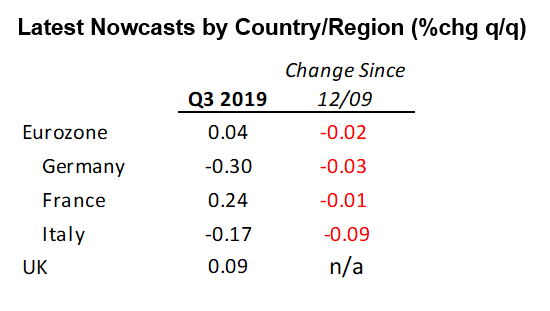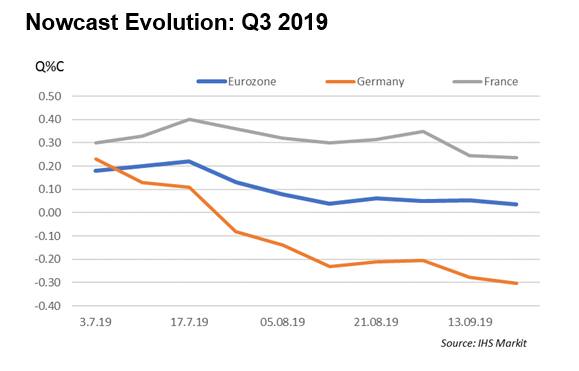IHS Markit European GDP Nowcasts: September PMI data pull EZ nowcasts lower
In July 2019 we introduced two nowcasting models for the eurozone and the UK. The models utilise a range of data widely used to track economic developments and provide timely estimations of quarterly GDP growth.
As the datasets include information provided from business surveys, official statistics offices and the financial markets, there is a steady flow of new data available to us during a quarterly nowcasting cycle. With our model frameworks comfortably able to incorporate this new information in a statistically efficient manner, this calls for regular, real-time, nowcast updates which we present in this new report.
Alongside the nowcasts for the eurozone and the UK, we have also been able to extend our coverage to include updates for France, Germany and Italy.
Summary: 23rd September 2019
Today's flash PMIs for September have added to the picture of gloom across the eurozone, with our latest nowcasts seeing further downward revisions for the Eurozone, Germany, France and Italy.
For Germany, data have continuously disappointed to the downside throughout the Q3 2019 nowcasting cycle and September PMI figures were no exception.
Back in July our model was forecasting a rise in German GDP of +0.23% for the third quarter of 2019 but, following the incorporation of our September PMI figures - which showed the manufacturing economy deteriorating to the greatest degree since the depths of the financial crisis and signs of spillover into domestic markets - our model now predicts a decline in GDP of -0.30% q/q (see chart opposite for nowcast evolution over the third quarter).
Whilst technical factors may ensure that actual first estimates of GDP are not quite as severe as the model currently predicts (which tends to best capture underlying changes in output), the chances of Germany avoiding technical recession now appear to be slim.
Elsewhere, France remains a relative bright spot, with the respective nowcast holding broadly steady at +0.24%. In stark contrast, Italy is now estimated to be deteriorating at a sharper rate than previously reported (nowcast down to -0.17%, from -0.09%). Poor July trade data were key to the downward nowcast revision here.
For the euro area as whole, the region is broadly stagnating, with the nowcast for Q3 slightly lower at +0.04%. In line with our PMI data, that's the lowest estimate of growth since the first half of 2013.
Finally, with little in the way of new information since our last update, the UK nowcast remains unchanged at +0.09% for Q3 2019.


Paul Smith, Director, IHS Markit
Tel: +44 1491 461038
paul.smith@ihsmarkit.com
Joseph Hayes, Economist, IHS Markit
Tel: +44 1491 461006
joseph.hayes@ihsmarkit.com
© 2019, IHS Markit Inc. All rights reserved. Reproduction in whole
or in part without permission is prohibited.
Purchasing Managers' Index™ (PMI™) data are compiled by IHS Markit for more than 40 economies worldwide. The monthly data are derived from surveys of senior executives at private sector companies, and are available only via subscription. The PMI dataset features a headline number, which indicates the overall health of an economy, and sub-indices, which provide insights into other key economic drivers such as GDP, inflation, exports, capacity utilization, employment and inventories. The PMI data are used by financial and corporate professionals to better understand where economies and markets are headed, and to uncover opportunities.
This article was published by S&P Global Market Intelligence and not by S&P Global Ratings, which is a separately managed division of S&P Global.
